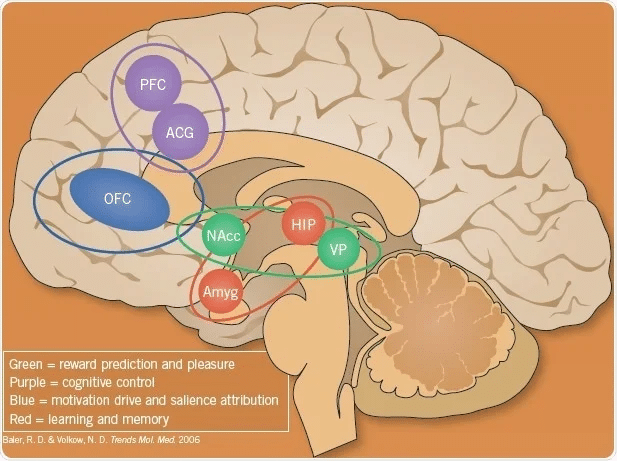Behind closed doors and in the minds of countless individuals, there is a constant battle that makes them weak, dependent on an external substance, and a threat to their lives. Drug addiction isn’t a rare concept anymore, as it can be seen that 1,38,543 million Americans aged 12 and above have been using drugs in their lifetime.
Addiction is a neurological condition that impacts the brain’s reward system. In a healthy individual, the reward system serves to encourage vital survival activities including eating, drinking, having sex, and interacting with others. For example, the reward system ensures that you reach for food when you are hungry because you know that after eating you will feel good. This system is taken over by drugs, which convert a person’s natural needs into drug needs.
Whether you’re someone who has personally faced the challenges of drug addiction, a concerned family member, or someone who just wants to deep dive into how the drug addiction process takes place and what are the causes, symptoms, and treatment for it, you have arrived at the right place as this blog aims to provide insight, knowledge, and resources to detangle the history of drug addiction.
What Is Drug Addiction?
Drug addiction, also known as psychological dependence, happens when someone feels they can only feel good (it’s called euphoria in technical terms) by taking a specific drug.
We all are vulnerable to addiction because drugs work on areas of the brain that are essential for how we live our lives, and drugs change the way we think. They change the way we prioritize things in our lives and they change the way the environment looks to us. We then associate drugs with changes in mood, people, and places, and hence,. we become conditioned.
It is comparatively easy for any one of us to face any type of drug addiction and if we compare the brain functions in a brain with substance abuse vs a normal brain, we can draw an interesting comparison between the two.
While we we find a clear disparity in thoughts, a normal brain catches a natural signal of positivity and achievement through real-life tasks and rewards, and someone getting a kick through drugs finds it difficult to get a dopamine rush hence leading to this substance use disorder. Slowly and steadily, this drug abuse converts into drug addiction and the whole body is dependent on this drug.
When you regularly abuse your body with such substances, your brain reaches a threshold point, and hence, to get the same dopamine rush, you need an increased quantity of the substance.
The Scientific Process Of Addiction
Neurotransmitters, are chemical messengers used by the brain’s billions of neurons, or nerve cells, to communicate with one another. An electrical impulse known as an action potential is produced when a neuron is sufficiently stimulated. This impulse then travels down the axon to the nerve terminal. In this instance, it causes a neurotransmitter to be released into the synaptic cleft, which is the area between neurons. After attaching itself to a receptor on a nearby neuron, the neurotransmitter sends a signal to that neuron, conveying the information.
The principal reward pathways entail the transfer of dopamine from the midbrain’s Ventral Tegmental Area (VTA) to the limbic system and frontal cortex. Fun activities cause action potentials to fire in the VTA’s dopamine-producing neurons. Dopamine is released into the synaptic space by the neurons as a result. Afterward, dopamine attaches itself to the receiving neuron’s dopamine receptors and activates them. It is thought that this dopamine stimulation results in rewarding or pleasurable feelings.

Dopamine molecules go back inside the transmitting neuron after being in the space between neurons. They’re surprised by a special protein called dopamine-transporter. Most drugs that people abuse increase dopamine levels in the reward system. Certain substances, like heroin, alcohol, and nicotine, cause the dopamine-producing neurons in the ventral truncus amygdala to fire more action potentials. The nerve terminal is where cocaine acts. It attaches itself to the dopamine transporter and prevents dopamine from being reabsorbed.
Methamphetamine is a psychostimulant that blocks the removal of dopamine like that of cocaine. Furthermore, even in the absence of action potentials, they can enter the neuron and enter the dopamine-containing vesicles, where it causes the release of dopamine.
The only rewarding thing left in the system is the drug; it is no longer responsive to normal stimuli. This is how drug use alters a person’s priorities in life. You need more of the drug to feel good because, over time, the drug becomes less effective at making you feel rewarded. In the end, this results in a drug overdose.
According to the Centers for Disease Control and Prevention, more than 1,12,000 drug overdose cases have been witnessed as of May 2023. This is the most drug overdose deaths ever recorded in a single year in the United States.
Only when we know the real cause, we can heal the root and therefore automatically liberate ourselves from every other drug addiction too, like not being able to stop taking drugs, drug cravings, moodiness, bad temper, feeling powerless, loneliness, relational problems, etc.
Causes of Drug Addiction
Each drug produces different effects on the brain but the addicting drug causes a change in your brain that interferes with the ability to think, control your behavior and at the same time send intense impulses to take drugs. It is because of this change that a person faces drug problems and over time, becomes challenging for an addicted person to stop drugs.
Like many mental disorders, drug abuse which leads to addiction, has no single cause. Many factors may contribute to the development of drug addiction the main factors are:
- Genetics: Genes account for 40-60% of a person’s risk of addiction and while it’s a constant interplay of genetics and environmental factors, there is scientific evidence to prove that genes play an important role in determining an individual’s vulnerability to addiction and accordingly lays down the risk factors in long-term. Genetic predisposition, heritability, genetic variations, and comorbidity with mental disorders are some of the factors that can increase the risk of drug addiction in an individual’s body.
- Environmental influence: The people we surround ourselves with, and the kind of environment we grow up in influence the kind of activities that we take up over some time. How often you take drugs depends on how easy they are to get, and what drugs you’re around is influenced by the people you hang out with. Factors including family and household dynamics, early exposure and trauma, economic and social factors, stress levels and mental health, media, and cultural influences, and access to treatment and support determine how early you would get addicted to drugs.
- Upbringing: You must have heard the quote that you are an average of the 5 people surrounding you and it’s most evident that you are in direct contact with your family most of the time. While a family history of drugs and addiction can be a reason for you to take up such substances, you cannot see such situations in many households. Parental abuse or neglect, poor relationships with family members, inadequate supervision over adolescents’ activities, and unstable home environments are some of the core reasons that children take up abusive activities at early ages and then find it difficult to navigate their way out of it.
- Psychological problems: Individuals dealing with mental health disorders such as depression, anxiety, bipolar, and personality disorders can use drugs as an escape mechanism for their current symptoms. Whenever someone is dealing with both of these situations at the same time, it is called a co-occurring or dual diagnosis and this makes the treatment for both the disorders difficult. If defined in phrases, impaired judgment, escapism, impulsivity, psychological cravings, emotional regulations, and self-esteem issues can be some predominant factors for drug abuse which can later convert to drug addiction.
- Self-doubt: It can be scientifically seen that people with high neuroticism levels have a high tendency to self-doubt and self-criticize. It can occur at a level where the person needs an external substance to escape this feeling and be in their dreams.
Low self-esteem, negative social influence, and impaired decision-making can be some undermining factors for a person to take up drugs. If someone can’t make sensible choices and keeps getting stuck in addictive behaviors, it’s really important to see a consultant and get professional help.
Commonly Abused Substances
According to an article by National Institute on Drug Abuse, marijuana, and nicotine vaping has seen a significant rise in the last five years and is maximum in adults between 35-50. Here are some commonly abused substances, their adverse effects, and ways to handle them efficiently:
- Amphetamine: This is known as a powerful stimulator for the central nervous system which is used to treat some severe medical conditions like ADHD, and narcolepsy but is generally considered, considered an addictive substance and its direct intake can pose a lot of long-term health issues. People often use it as a recreational drug to feel happy, alert, and more sociable. It helps them experience euphoria, stay awake, enhance their thinking abilities, and be more at ease in social situations. In worse cases, this drug abuse can cause acne, restlessness, delusions, cardiovascular problems, blurred vision, and muscle breakdown. Treatment for rising above this drug may be long-term and may involve periods of difficulty as a person adjusts to their life without substance use.
- Cocaine: Cocaine is derived from the South American native coca plant and is used as a source of local anesthesia by experts. However, its recreational use is illegal, and when consumed directly without any solid reason, this white crystal powder can be as dangerous as leading to drug overdose deaths. Sometimes, people mix this with safer stuff like talcum powder or cornstarch to make more of it. But if it’s mixed with things like fentanyl (a strong painkiller) or amphetamine (a type of stimulant), it can become really addictive and risky. Increased use of cocaine can lead to nausea, restlessness, unstable heartbeat, constricted blood vessels, increase in body temperature and blood pressure. Cognitive behavioral therapy, contingency management like rewarding patients as a result of consuming less or no substances, and building and joining therapeutic communities can be some of the proven treatment methods to cure drug addiction due to cocaine.
- Alcohol: Alcohol is a very common addictive substance. When someone can’t stop drinking alcohol, it’s called alcohol addiction. It’s a problem that keeps coming back over time. Just like with other drug problems, abusing alcohol affects the brain a lot. It can make a person feel good, but it also causes some really bad feelings.
There are three stages in the alcohol use disorder cycle-
- Intoxication stage: When you repeatedly activate the reward system in your brain called the basal ganglia, it increases the likelihood of drinking alcohol again. This reinforces the habit of consuming alcohol regularly. In the end, this recurrent activation of the basal ganglia also causes alterations in the way an individual reacts to stimuli related to alcohol consumption, such as certain individuals, associate drinking alcohol with particular glasses, pictures, locations, people, etc. These cues have the potential to gradually produce strong cravings for alcohol.
- Withdrawal stage: When someone who’s hooked on alcohol quits drinking, they go through withdrawal symptoms. These symptoms are the opposite of the good feelings that alcohol can bring. These symptoms might manifest as emotional (dysphoria, anger, anxiety, and emotional anguish) or physical (disorders in sleep, pain, and sensations of disease). There are two theories as to why withdrawal from alcohol can cause unpleasant emotions. First, people find it more difficult to enjoy the small pleasures in life when their basal ganglia’s reward mechanisms are less activated, a condition known as a reward deficit. Next, feeling anxious, irritated, or uneasy happens when the brain’s stress systems become extra active. This is often called a ‘stress overload’ and it occurs in the expanded amygdala. At this point, the individual no longer consumes alcohol to experience a pleasant high, but instead to escape the low feelings.
- Anticipation stage: This is the point where someone who has abstained from alcohol for a while starts to seek it out once more. Someone becomes very focused on alcohol, constantly thinking about where to get more and eagerly looking forward to the next time they can drink. People who can’t stop drinking alcohol find it difficult to use a part of their brain called the prefrontal cortex. This part helps with executive functions, like sorting out what’s important, managing time, and making decisions. This makes this part of the brain crucial at this point.
Signs And Symptoms Of Drug Addiction
A regular urge to use drugs daily or even several times a day can prevent an individual from meeting his/her daily responsibilities of maintaining and building relationships, learning, thriving in their career, improving their health, etc. Here are some signs you can see in someone who might be addicted to drugs. These signs can help you understand how a person addicted to any kind of drug might appear, feel, and act.
- Repetitive drug abuse: If someone is trying to avoid life problems, isn’t ready to deal with the results, and is using drugs even when it’s risky, it’s a sign they need help. It’s important to talk to a specialist and consider getting treatment right away.
- Withdrawal symptoms: If a person is addicted to a particular substance, there are high chance that they already know about it but are unable but unable to do anything solid to see results. You can see increasing withdrawal symptoms like avoiding socializing, facing failure at every attempt to stop drugs, and decreased motivation after an unsuccessful trial of controlling the use of the drug.
- Self-harming: After a certain level, the person dealing with drug use disorders wants to leave drugs due to moral, and ethical reasons, they just can’t. Continual use of the drug even though the person is aware of recurring physical and/or psychological problems deteriorates his/her condition, making it difficult to receive treatment in the most optimal form.
- Going broke: A need to keep or maintain a constant supply of the drug Spending more money on drugs even when it’s out of your budget.
- Pushing negative limits: You can know if someone is really into a substance by noticing big changes in how they act. They might start acting in ways that seem mean or not like themselves. They could end up doing things like spending all their money on addictive stuff, barely having enough to get by, or even stealing to support their habit. These things might not be what they’d usually do if they weren’t so caught up with that substance.
Seeking Professional Help And Treatment
To fully understand the repeating patterns in the body, it might be necessary to have a careful assessment by professionals like a psychiatrist, psychologist, or licensed alcohol and drug counselor. It’s usually a good idea to talk to an expert if you think you’re dealing with drug abuse. We can help people with addiction and they can get better. Treatment works well for addiction. About 10% of American adults who are at least 18 years old say they are in recovery from an alcohol or drug abuse issue.
Here’s how you can seek professional help for drug treatment:
- Outpatient Rehabilitation: Outpatient programs allow individuals to receive treatment while living at home. These programs are more flexible but may be less intensive than inpatient programs. They often include group therapy, individual counseling, and educational sessions.
- Medication-Assisted Treatment (MAT): MAT involves the use of medications in combination with counseling and therapy. It is particularly effective for opioid and alcohol addiction. Medications like methadone, buprenorphine, and naltrexone can help reduce cravings and withdrawal symptoms.
- Behavioral Therapy: Different types of behavioral therapy, like cognitive-behavioral therapy (CBT), contingency management, and motivational enhancement therapy, are used to tackle the psychological reasons behind addiction. These therapies assist individuals in building coping skills to deal with their challenges.
However, there isn’t much availability of adequate training that a physician and nurse practitioners should receive. Only 1 out of 4 practitioners receive necessary addiction training during their medical degree. Hence, one should be careful with the selection of the best consultant and treatment center to ensure the right results.
Frequently Asked Questions
Can drug addiction be treated at home?
Because drug abuse can be complicated, it’s best to seek advice from an expert and get proper treatment. However, detoxification is one of the effective processes to treat drug addiction at home where you start taking your body away from these harmful substances while dealing with the withdrawal symptoms. To achieve the best results quickly, experts conduct this process during therapy sessions.
How does an addictive substance affect our brain?
Different drugs act in different ways but the common outcome is that dopamine builds up in the synapse to a much greater amount than normal. This causes a continuous stimulation, maybe over-stimulation of receiving neurons, and is responsible for prolonged and intense euphoria experienced by drug users. Repeated exposure to dopamine surges caused by drugs eventually de-sensitizes the reward system.
What is Withdrawal?
Withdrawal refers to the range of symptoms experienced following a reduction in or abrupt cessation of long-term drug use. Depending on the drug type, withdrawal symptoms and length differ. For instance, restlessness, muscle and bone pain, insomnia, diarrhea, vomiting, and cold flashes are some of the physical signs of heroin withdrawal. The general depression, or dysphoria (the opposite of euphoria), that frequently accompanies heroin withdrawal may linger for weeks in contrast to the few days that these physical symptoms may last. Medication can often effectively alleviate the symptoms of withdrawal; however, treating withdrawal is not the same as treating addiction.
Conclusion
Becoming really into something is easy, but getting away from that habit or addiction needs a lot of hard work. We, at Calusa Recovery, are there with you to guide, support, and help you get out of any type of drug addiction by giving you the treatment and resources to control your addictive symptoms and lower your dependence on such substances. We give you access to support groups and therapy sessions that help you maintain your drug addiction treatment for a long time.









